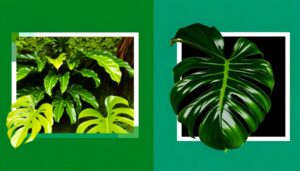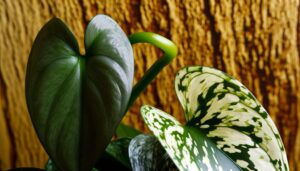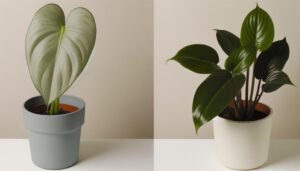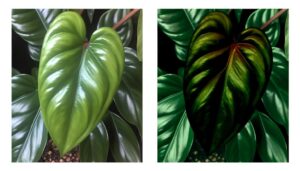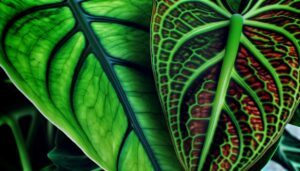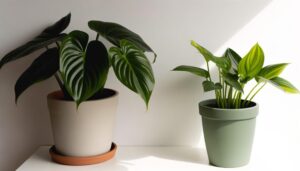Heartleaf Philodendron Vs Monstera: A Comparison Guide!
Heartleaf Philodendron (Philodendron hederaceum) and Monstera (Monstera deliciosa) are tropical plants thriving in similar environments but showcasing distinct features. Heartleaf Philodendron has small, glossy, heart-shaped leaves, while Monstera exhibits large, perforated leaves adapted for ideal light capture.
Philodendrons are primarily trailing or climbing with aerial roots, whereas Monstera grows robustly upright supported by thick stems and adventitious roots. Both require bright, indirect light and specific watering schedules: consistently moist for Heartleaf Philodendron and moderate with drying intervals for Monstera.
Proper care enhances their air-purifying qualities, contributing to a healthier indoor atmosphere. Discover more about their unique characteristics and care requirements.
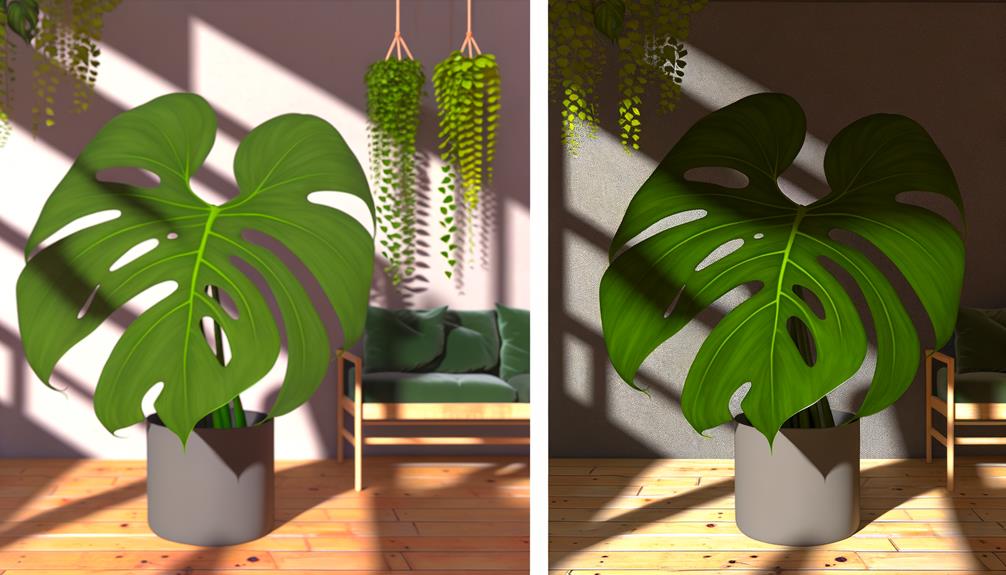
Comparison of Heartleaf Philodendron and Monstera
| Specification | Monstera | Split-Leaf Philodendron |
|---|---|---|
| Scientific Name | Monstera deliciosa | Philodendron hederaceum |
| Mature Size | Up to 10 feet indoors | 10-20 feet |
| Native Region | Southern Mexico | Central and South America |
| Leaf Appearance | Large, split leaves with fenestrations | Large, heart-shaped leaves |
| Growth Difficulty | Beginner-friendly | Beginner-friendly |
| Soil Preference | Light, well-draining | Light, well-draining |
| Sun Exposure | Indirect sunlight | Bright, indirect light |
| Lighting Tolerance | Low-light tolerant | Low-light tolerant |
| Fertilization Needs | Every few weeks | At least once a month |
| Leaf Texture | Smooth, waxy | Slightly textured |
| Growth Habit | Climbing with aerial roots | Upright growth |
| Leaf Shape | Heart-shaped | Feather-shaped |
Origins and Natural Habitat
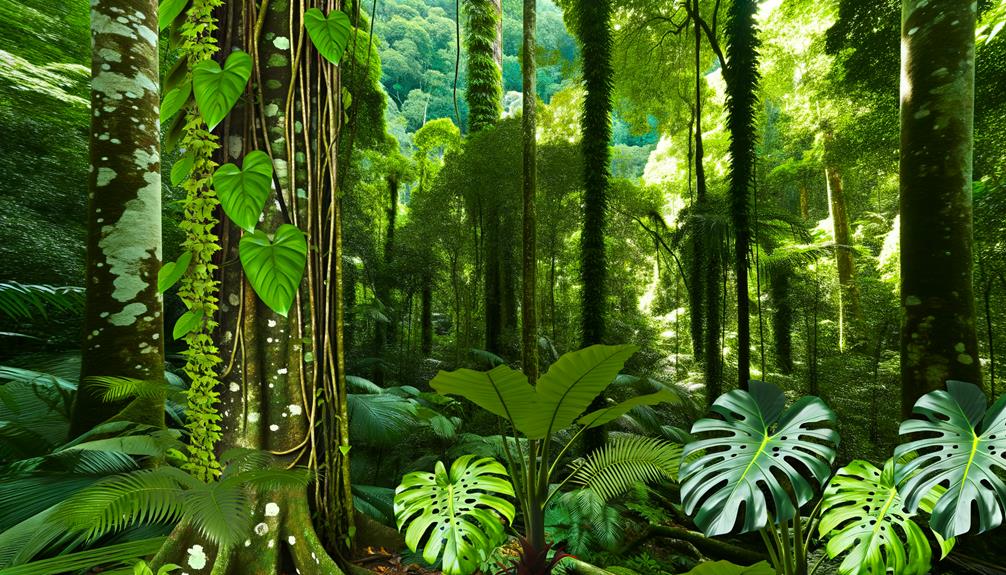
The Heartleaf Philodendron (Philodendron hederaceum) and Monstera (Monstera deliciosa) both originate from the tropical rainforests of Central and South America, where they thrive in the understory layer. This environment provides dappled sunlight, high humidity, and rich, well-drained soil conditions that are essential for their growth.
These plants have evolved as epiphytes, meaning they often grow on other plants, such as trees, to access light and air. In their natural habitat, they benefit from the warm temperatures and consistent moisture levels, which enable their aerial roots to absorb water and nutrients effectively.
The dense canopy overhead filters sunlight, creating an ideal low-light environment that mimics the conditions found in many indoor settings, making these species popular as houseplants.
Leaf Shape and Size
The Heartleaf Philodendron (Philodendron hederaceum) is characterized by its small, heart-shaped leaves, typically measuring 2-4 inches in length.
In contrast, the Monstera (Monstera deliciosa) exhibits large, fenestrated leaves that can grow up to 3 feet long, featuring natural splits and holes.
These distinctions in leaf shape and size result from each plant’s unique growth patterns and environmental adaptations.
Distinct Leaf Silhouettes
Frequently distinguishable by their unique leaf silhouettes, Heartleaf Philodendron and Monstera exhibit significant differences in leaf shape and size.
The Heartleaf Philodendron (Philodendron hederaceum) typically features small, heart-shaped leaves that are smooth, glossy, and uniform in texture. These leaves are relatively compact, averaging 2-4 inches in length.
In contrast, the Monstera (Monstera deliciosa) is renowned for its large, fenestrated leaves, which can grow up to 3 feet long. The distinctive perforations and splits in Monstera leaves not only enhance their aesthetic appeal but also serve functional purposes, such as reducing wind resistance and maximizing light capture.
This unique morphology contributes to Monstera’s dramatic and exotic appearance, contrasting sharply with the more understated elegance of the Heartleaf Philodendron.
Growth and Dimensions
When comparing the growth and dimensions of Heartleaf Philodendron and Monstera, one observes a stark contrast in their respective leaf morphologies and developmental patterns.
The Heartleaf Philodendron (Philodendron hederaceum) typically has small, heart-shaped leaves that measure approximately 2-4 inches in width.
In contrast, the Monstera (Monstera deliciosa) is renowned for its large, fenestrated leaves, which can reach up to 35 inches in length under ideal conditions.
Importantly, the following distinctions are evident:
- Leaf Size: Heartleaf Philodendron has smaller, more compact leaves.
- Leaf Shape: Monstera leaves feature characteristic splits and holes, unlike the smooth-edged Philodendron.
- Growth Habit: Monstera demonstrates a more vigorous, climbing growth, whereas Heartleaf Philodendron exhibits a trailing, vining habit.
Growth Patterns
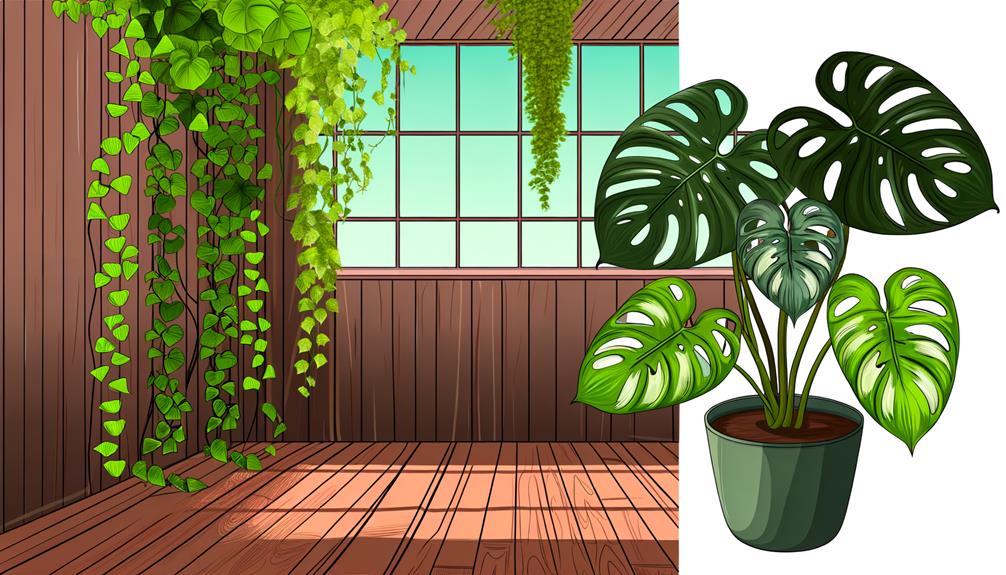
Regarding growth patterns, Heartleaf Philodendrons exhibit a more trailing or climbing habit, while Monstera species tend to develop a more robust, upright structure with fenestrated leaves.
Philodendron hederaceum, commonly known as Heartleaf Philodendron, employs aerial roots to cling to surfaces, making it ideal for hanging baskets or climbing poles.
In contrast, Monstera deliciosa, often referred to as Swiss Cheese Plant, grows in a more vertical manner, aided by its substantial, perforated foliage that maximizes light absorption. This vertical growth is supported by thick, sturdy stems and adventitious roots that anchor the plant.
Both species display remarkable adaptability, yet their distinct growth patterns cater to different aesthetic and spatial preferences, offering unique choices for indoor horticulture.
Light Requirements
Heartleaf Philodendron and Monstera species exhibit distinct preferences regarding light requirements. While both plants thrive in bright, indirect light, Monstera can tolerate brief periods of direct sunlight, unlike the Heartleaf Philodendron which is more sensitive.
Additionally, both species demonstrate a remarkable adaptability to lower light conditions, yet prolonged exposure to shade may impact their growth and overall health.
Ideal Light Levels
Both the Heartleaf Philodendron (Philodendron hederaceum) and the Monstera (Monstera deliciosa) thrive under bright, indirect light conditions, though they can tolerate lower light levels with varying effects on growth and foliage health. Optimal light levels are essential for maximizing their aesthetic appeal and physiological functions.
Key considerations include:
- Growth Rate: Adequate light promotes robust growth, while insufficient light may result in slower development and elongated stems.
- Leaf Size and Color: Proper lighting enhances leaf size and maintains vibrant coloration, whereas poor light can cause smaller, paler leaves.
- Photosynthesis Efficiency: Sufficient light ensures effective photosynthesis, crucial for energy production and overall plant vitality.
Understanding these factors aids in creating an ideal environment for both species.
Direct Vs. Indirect
Frequently, understanding the difference between direct and indirect light is fundamental for ensuring the best growth and health of both the Heartleaf Philodendron and Monstera. Direct light involves sunlight that reaches the plant without obstruction, characterized by intense brightness and potential for leaf scorching.
Conversely, indirect light is filtered or diffused, often through curtains or reflected off surfaces, providing a gentler illumination. The Heartleaf Philodendron thrives in bright, indirect light, minimizing risks of leaf burn. Similarly, the Monstera prefers bright, indirect light but can tolerate some direct light exposure.
It is important to monitor light conditions to avoid excessive direct sunlight, which can lead to photoinhibition and chlorophyll degradation, ultimately affecting plant vitality and growth.
Adaptability to Shade
Adaptability to varying light conditions is a notable trait of both the Philodendron hederaceum and Monstera deliciosa, enabling them to thrive even in shaded environments where direct sunlight is scarce.
Philodendron hederaceum, commonly known as Heartleaf Philodendron, exhibits a high tolerance to low light, making it ideal for dim interiors.
Monstera deliciosa, or Swiss Cheese Plant, while preferring brighter, indirect light, can also adapt to lower light conditions albeit with slower growth and reduced leaf fenestration.
Key points include:
- Philodendron hederaceum: High tolerance to low light, minimal growth impact.
- Monstera deliciosa: Prefers indirect light, adaptable to shade, slower growth in lower light.
- Both species: Suitable for indoor environments with varying light availability.
Watering Needs
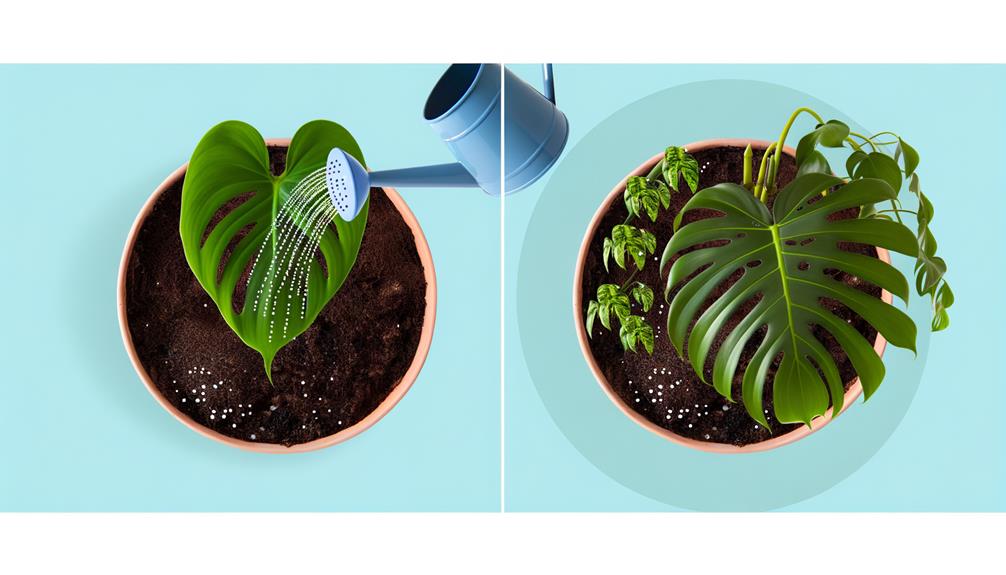
The watering requirements for Heartleaf Philodendron and Monstera plants differ substantially due to their distinct native habitats and physiological characteristics. Heartleaf Philodendron, originating from tropical rainforests, thrives in consistently moist soil but should not be waterlogged. It requires regular watering, ensuring the top inch of soil is dry before re-watering.
Conversely, Monstera, adapted to periodic tropical droughts, prefers a moderate watering regimen. Allow the soil to dry out between waterings to mimic its native epiphytic conditions, which prevent root rot.
Both plants benefit from high humidity, but overwatering can be detrimental. Employing a well-draining potting mix and ensuring proper drainage holes can aid in meeting their specific hydration needs, reducing the risk of over-saturation and associated root diseases.
Soil Preferences
Understanding the distinct watering needs of Heartleaf Philodendron and Monstera provides a foundation for exploring their specific soil preferences, which are equally important for their best growth.
Heartleaf Philodendron thrives in well-draining, aerated soil with organic matter. Conversely, Monstera prefers a slightly chunkier mix to support its epiphytic nature. Both plants benefit from soil that retains moisture without becoming waterlogged.
Key soil characteristics include:
- Drainage: Essential to prevent root rot, especially critical for Heartleaf Philodendron.
- Aeration: Crucial for root health; achieved using perlite or orchid bark.
- Organic Content: Enriches soil, providing necessary nutrients for robust growth.
These factors ensure the prime environment for each plant’s unique physiological requirements, promoting overall health and vigor.
Common Pests and Diseases
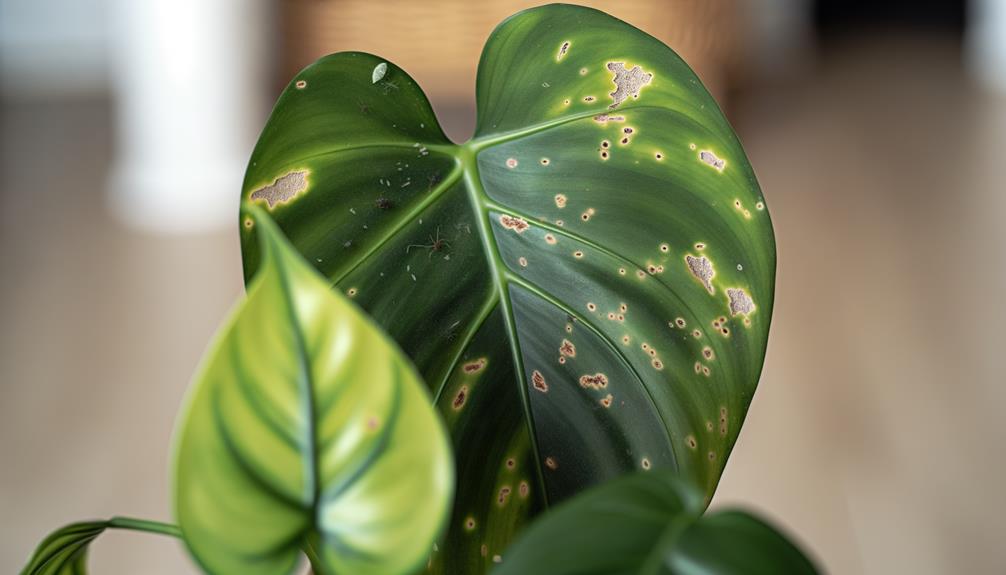
Both Heartleaf Philodendron and Monstera are susceptible to a variety of common pests and diseases that can significantly impact their health and growth. Among the most widespread pests are spider mites, aphids, and mealybugs, which feed on the plant sap, resulting in stunted growth and leaf discoloration.
Additionally, both plants are prone to fungal infections such as root rot and leaf spot, typically caused by overwatering and poor air circulation. Bacterial infections, like Erwinia blight, can also affect these species, appearing as watery lesions on leaves and stems.
Regular inspection and prompt intervention, including appropriate pesticide application and ensuring ideal growing conditions, are essential for maintaining plant health and mitigating the effects of these pests and diseases.
Propagation Methods
Promoting strong growth and health in Heartleaf Philodendron and Monstera not only involves managing pests and diseases but also understanding effective propagation methods to expand your plant collection.
Propagation through stem cuttings remains the most common and successful method for both plants.
- Stem Cuttings: Select a healthy stem with at least one node and aerial root. Cut below the node and place it in water or moist soil until roots develop.
- Air Layering: This technique, particularly effective for Monstera, involves wounding the stem and wrapping it with moist sphagnum moss until roots form.
- Division: Ideal for mature plants, this method involves separating the root ball into smaller sections, ensuring each section has sufficient roots and foliage.
These methods promote sustainable propagation while maintaining plant health.
Indoor Air Quality Benefits
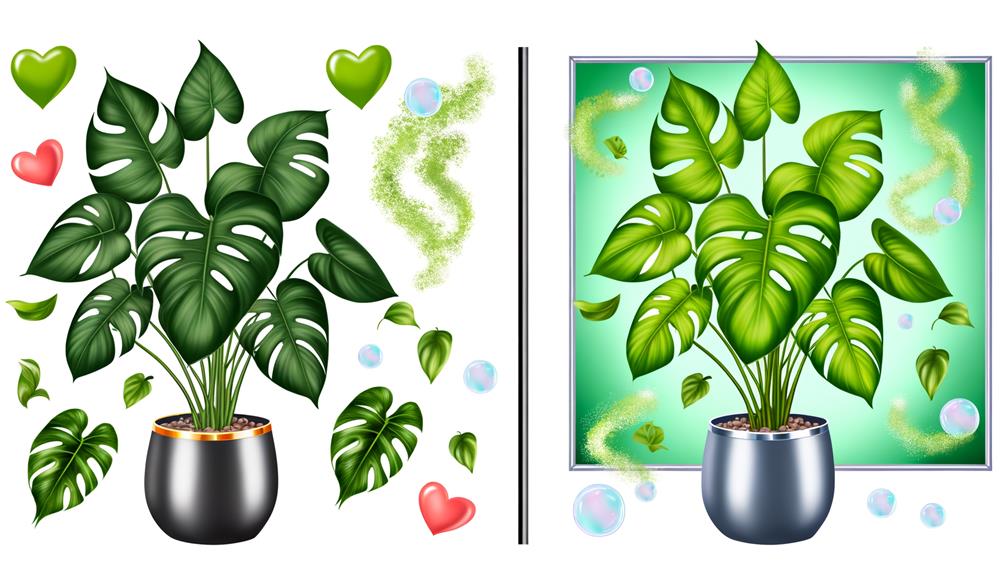
Heartleaf Philodendron and Monstera play a role in improving indoor air quality by effectively eliminating common pollutants like formaldehyde, benzene, and trichloroethylene. These volatile organic compounds (VOCs) can be found in household items such as furniture, paint, and cleaning products.
The Heartleaf Philodendron, scientifically known as Philodendron hederaceum, uses its wide leaves to absorb these toxins through stomatal openings, helping to transform them into less harmful substances. Monstera deliciosa, also known as the Swiss cheese plant, operates in a similar way, using its large, fenestrated leaves to increase surface area for pollutant absorption.
Both plants undergo photosynthesis, releasing oxygen and increasing humidity, thereby promoting a healthier indoor atmosphere. Their ability to cleanse the air highlights their combined aesthetic and practical value.
Conclusion
In comparing the heartleaf philodendron and monstera, their distinct origins, leaf structure, and growth behaviors highlight their unique adaptations and care needs.
Both species show specific preferences for light, water, and soil, which must be met to support peak growth.
Their propagation techniques and vulnerability to pests and diseases further distinguish their differences.
Which plant improves indoor air quality while matching cultivation abilities?
Ultimately, grasping these factors helps in choosing the suitable species for environmental and aesthetic preferences.

